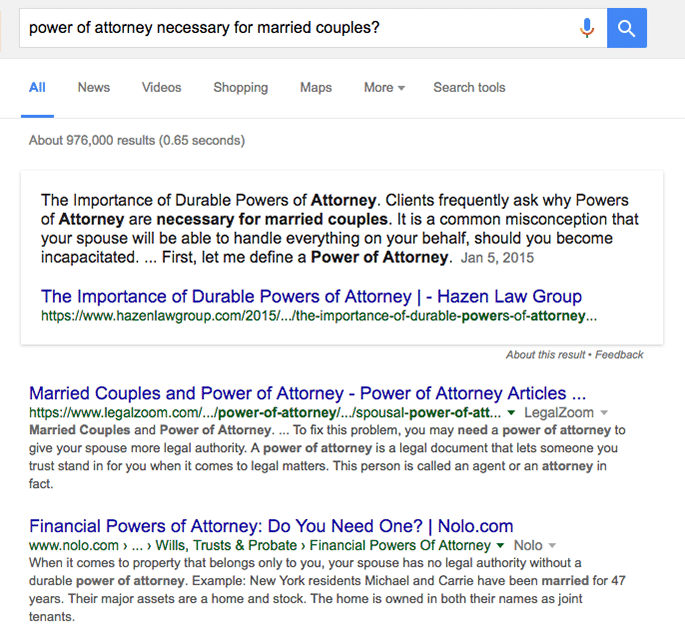Bill Gates wrote his essay, “Content is King” in 1996. Twenty years later, the phrase still continues to dominate the online marketing world.
Companies in all industries are in a rush to produce as much content as possible, hoping that something sticks — that some piece of content will hit upon the magic mix of luck, quality and value and become a viral sensation.
This rush has created glut of articles, blogs, lists and posts that are at best repetitive and at worst poorly-written and uninformative. It is impossible to consume a fraction of what is being written and overwhelming to try to separate the wheat from the chaff. It is from within this cacophony that attorneys must try to generate content that is somehow unique and gets people's attention.
But writing a certain number of blogs or posting an arbitrary number of Facebook updates because of some nebulous advice that more is better is not the best strategy for your firm. In content marketing, more is not necessarily better.
The Goldilocks Principle has been applied to many disciplines. It states that in any sample, some objects will fall into either extreme, while others will fall in the middle, or average. In content marketing, this can be restated to say that there is an ideal mix of content that falls in the middle — that is just right. Too much content is mind-numbing and redundant and will likely be indistinguishable from a lot of other content out there. To little content is incomplete, not answering questions that your readers need addressed. The middle, where content is helpful and informative without being overdone, is the goal.
Getting to just right
Here are some principles that will help your firm find both the right types of and the right frequency for content creation.
1. Analyze and consolidate current content
Almost no content has an infinite shelf-life. Change is inevitable, and even evergreen content must occasionally be revisited. Attorneys should be especially careful to review content regularly, since laws and the interpretation of those laws change over time. If it is 2016, and your website is still warning people to plan now before the estate tax is reinstated in 2011, then you have a credibility problem.
Content consolidation will help your firm align its assets — from blog posts to press releases to videos to social media posts — with its goals. Just because a certain piece of content exists and receives traffic does not mean that it is working for your firm. In fact, situations exist in which traffic may actually be harmful. A thorough analysis will show how users interact with your content and whether that content is convincing them to take the actions you want.
Consolidating content encompasses several steps:
- Finding duplicate or repetitive content that can be eliminated or combined to create more relevant and targeted pieces
- Uncovering outdated content that needs to be rewritten or removed
- Finding content that is not producing conversions and reworking it so that it speaks to people who are at specific stages of hiring an attorney
- Evaluating navigation and site structure to make sure users can easily find the best performing content
After going through the process of consolidating content, you may see less traffic, but you should see higher-quality traffic.
2. Repurpose content
One piece of content can be reformatted to serve several audiences. There is no need to struggle to meet an unrealistic production schedule when you have perfectly usable content already at your disposal. A long-form page can be transformed into a white paper and summarized into a blog post. It can be transformed into slides to be published on SlideShare or made into a seminar. Conversely, materials used for a seminar can be made into infographics or converted to a series of shorter blog posts. Videos can be transcribed, and FAQs can be transformed into topical videos. There is no reason to reinvent the wheel every time you publish; in fact it is beneficial to use content you know resonates with your clients to its maximum potential.
3. Experiment to achieve the right mix of organic content and paid content
There are seemingly endless ways to spend a marketing budget. Organic search engine marketing, paid ads, remarketing and social marketing are only a few. Moz divides this marketing mix into a pie that includes:
- · Display (ads)
- · Paid search
- · Offline marketing
- · Content marketing
- · SEO
- · Community
- · In-app
Each one of these avenues requires attention. It is easy to get stuck in a rut, expending the same amount of resources on the same types of content month after month. But search engines and website users aren't static. You may find that one month, bumping up expenditures on a PPC campaign is a good idea, while other months its best to invest in some informational content, while still others you may want to put more energy into offline networking. You do not necessarily want to always bid on a certain keyword just because you see your competitors are doing it any more than you want to always post two blog entries a week just because common wisdom says more content is better.
A proactive marketing company will look at your content mix every month and make adjustments as new opportunities become available and older strategies become stale.
4. Mix up content lengths
Long-form content is very hot. Several studies have shown that longer content tends to rank better with search engines and receive more likes, shares and engagement on social media. As a result, everyone is in a rush to produce long-form content — and the more the better.
Long-form content is a valuable asset for firms, and your firm should be publishing pieces that fit into this category. Thoughtfully-written pages that study a topic in-depth rank well and help establish your firm as a trustworthy resource. In fact, if your firm publishes a comprehensive piece on a niche subject, there is a chance Google will pull from that piece to create a Google Card.

However, not all content should be long-form. While such content does tend to rank well, it is also time consuming and expensive to produce. Because long content is resource-intensive, your firm will likely not be able to produce an abundance of it, and your longer content will have to target more competitive keywords. It is simply not practical for every piece of content to be long-form. Additionally, while long-form content builds your authority, it may not be your best converting content.
Always look at analytics to see how different types of content, and content on different subjects, is resonating with audiences. You may be surprised to find that some of your highly-trafficked posts are under 700 words. This is because, while long-form content is generally well-received, not everyone likes reading it. Also, not every subject requires a long discussion. Some questions can be answered succinctly, in 500 words or less, and if that is that case, 500 words are all your firm should give that topic. Strategically mixing short and long content helps you allocate resources where they are most effective.
5. Focus less on quantity and more on impact
The push to constantly produce content can obscure the reasons behind producing it. The “If you Build It They Will Come” theory does not hold up in content marketing. Instead, you must understand the people who are potentially your clients, produce content that speaks to them and market it effectively.
You must know how different content influences people who are in different stages of hiring an attorney. Some content should explain to people why they need and attorney (and why they need you) while other content should push those who have already decided to hire an attorney to act. If you are able to produce fewer pieces of higher quality that persuade and convince, you are that much closer to just right.

